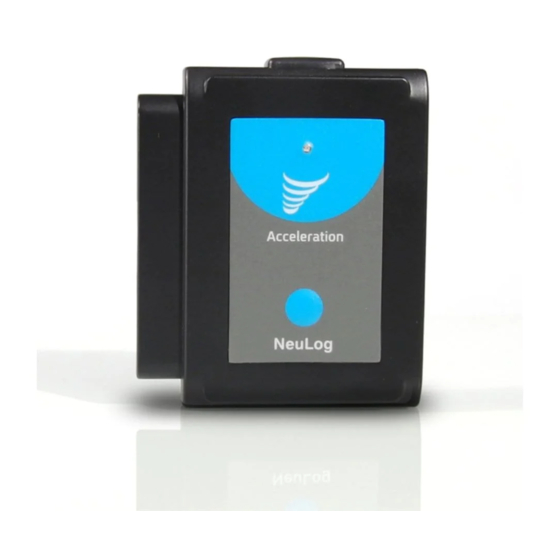
Advertisement
Quick Links
NeuLog acceleration logger sensor
NUL-227
The NeuLog acceleration sensor can be used for any science experiment which
utilizes acceleration measurements such as in the fields of Physics, Mechanics,
Physiology, Exercise Science, etc.
The sensor comes pre-calibrated so you can start experimentation right out of the box
using this guide.
Among hundreds of possible experimental subjects that can be studied with the NUL-
227 sensor are: gravitational force, impulse, exercise studies, human and animal
acceleration, and many more.
The acceleration sensor's measurement unit is:
2
Meters per second squared (m/s
): The SI unit of acceleration or change in velocity
over time.
Sensor's orientation:
The NeuLog acceleration sensor (an accelerometer) measures static acceleration due
to gravity and dynamic acceleration due to the sensor's motion. By measuring static
acceleration, one can find out the angle the sensor is tilted with respect to the Earth.
By measuring dynamic acceleration, one can find out how the velocity of the sensor
changes with time.
When the sensor is not moving and is facing upwards, the reading is 9.8 m/s
(because it includes static acceleration). When the sensor is at free fall and is facing
2
upwards, the reading is 0 m/s
. If we are interested only in the vertical axis (Z axis)
and in the dynamic acceleration, we can subtract 9.8 m/s
m/s2 when the sensor is not in motion and -9.8 m/s
The NeuLog acceleration sensor has the ability to measure acceleration in three
different axes (X, Y and Z). The figure below demonstrates the axes.
Note: You can also determine each axis by using an easy method: First, click on the
"Module setup" button located in the acceleration sensor module box in the NeuLog
application and select the axis you wish to determine. Then change the physical
NEULOG ACCELERATION LOGGER SENSOR GUIDE
2
2
from the readings and get 0
2
when the sensor is at free fall.
orientation of the acceleration sensor until the readout is roughly ± 9.8m/s
2
sensor reads roughly ±9.8m/s
, draw an imaginary line through the sensor towards the
ground, either end of the imaginary line (sky and ground) will be the poles of the axis
in relation to the sensor you are trying to determine.
To view all axes simultaneously:
After collecting data:
1.
Open the NeuLog application and connect the acceleration sensor using one of
the guides.
Once the sensor has been detected, click on the "Off line Experiment" icon.
2.
Click on the acceleration sensor "Module setup" button located in the
3.
acceleration sensor module box on the left side of the screen.
Click on the "Range" button and select an axis (X, Y, or Z).
4.
Click the "Load Experiment" icon located on the top of the screen.
5.
6.
Click on the experiment you would like to upload so that the button turns green;
the default is "Newest" (selects the most recent data collection).
Click again the "Load Experiment" icon to load the data from your chosen axis
7.
onto the graph.
8.
Repeat from step 3 to load the other axes on the same graph.
2
. When the
Advertisement

Summary of Contents for NeuLog NUL-227
- Page 1 Note: You can also determine each axis by using an easy method: First, click on the “Module setup” button located in the acceleration sensor module box in the NeuLog application and select the axis you wish to determine. Then change the physical...
- Page 2 NeuLog WiFi network which will stream the NeuLog data to a device of your choosing. Once your device is wirelessly connected to the NeuLog Your acceleration sensor needs to be connected to a USB-200 module. The USB-200 network, you can run experiments and collect data through a browser of your module then connects to a computer via a USB to mini-USB cable.
- Page 3 Select which experimental data to upload (5 experimental runs can be stored at Procedure: one time on the NUL-227 acceleration sensor). Connect the acceleration sensor to the left side of the viewer. Connect the BAT-200 module to the right side of the viewer.
- Page 4 ±80 m/s ability to store its own data due to an internal flash memory chip and micro-controller modes in each plastic NeuLog body. This technology allows the sensor to collect and then ADC resolution 10 bit store the digital data in the correct scientific units ( F, Lux, %, ppm, for example).
- Page 5 NEULOG ACCELERATION LOGGER SENSOR GUIDE Thank you for using NeuLog! Warranty: We promise to deliver our sensor free of defects in materials and workmanship. The warranty is for a period of 3 years from the date of purchase and does not cover damage of the product caused by improper use, abuse, or incorrect storage.













Need help?
Do you have a question about the NUL-227 and is the answer not in the manual?
Questions and answers